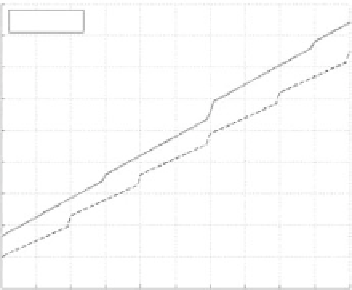Image Processing Reference
In-Depth Information
Hardware cost comparison for many shared nodes
Hardware cost comparison for many shared nodes
Shared networks
Dedicated networks
Shared networks
Dedicated networks
Dedicated
networks are
better in this
application
Shared network
is better in this
application
Increasing number of nodes
Increasing number of nodes
(a)
(b)
FIGURE .
Illustration of the application of the weighted analytical perspective resulting in decisions of (a)
shared or (b) dedicated networks for supporting control and safety functionality, respectively, depending on weights
chosen.
The weights should be chosen to reflect the particular NCS application environment. Equation .
is normalized so that factors can be incrementally added to the formulation as these factors are
quantified during the course of understanding the NCS environment. Note that Equations .
and . assume that the factors are independent; thus, as noted earlier, care should be taken to
ensure that factors do not overlap.
Figure . illustrates this analysis applied to the decision of utilizing (separate) dedicated vs.
shared networks to support control and safety NCS functionality. Depending on the prioritization of
factors, the best solution can vary.
It is important to note that manufacturers tend to consistently overemphasize upfront costs such
as installation and underemphasize recurring maintenance and performance costs when making
network decisions. Utilizing the more formalized approach presented here, this “forgetting” of the
recurring costs can be avoided [].
23.5 Applications for Industrial Networks
In this section, we briefly describe current trends in the use of networks for distributed multilevel
control, diagnostics, and safety. There is an enormous amount of data produced in a typical man-
ufacturing system, as thousands of sensors record position, velocity, flow, temperature, and other
variables hundreds of times every minute. In addition to this physical information, there are the
specifications for the parts that must be produced, the orders for how many parts of each type are
needed, and the maintenance schedules for each machine. Generally, the information content can
be thought of as supporting a control, diagnostics, or safety function, or some combination of these.
To support the aggregate of these functions in a manufacturing environment, separate networks are
often employed, where each network is dedicated to one or more function types, such as control and
diagnostics, with the network protocol chosen that best fits (i.e., balances) the QoS requirements of
the function type(s). In this section, networks for these function types are explored, focusing on the
QoS requirements that often govern the network protocol choice.
































